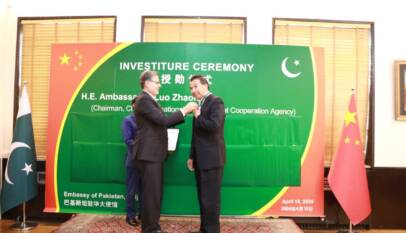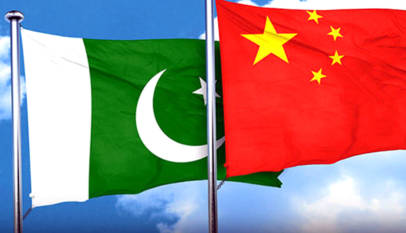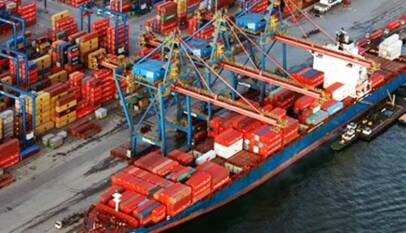CPEC Joint working group adopts three new highways, discusses other projects
To further advance connectivity in the country and overhaul the existing infrastructure, the CPEC Joint Working Group on Transport Infrastructure adopted three major road projects in Pakistan during the eighth meetings of the group. The meeting adopted the construction of a motorway from Peshawar to DI Khan (320 kilometers), Swat Expressway from Chakdara to Fatehpur Phase-II (182 kilometers), and Dir Expressway (30 kilometers). Officials from Pakistan’s side also discussed the Mainline (ML)-1 project, Karachi Circular Railway (KCR), Peshawar Circular Railway (PCR), and Quetta Mass Transit Project. Chitral-Shandoor-Gilgit, Nokundi-Mashkhel-Panjgur, and Mirpur-Muzaffarabad-Mansehra projects.
ISLAMABAD:
The China-Pakistan Economic Corridor (CPEC) Joint Working Group on Transport Infrastructure on Monday adopted three major road projects in Pakistan during the eight meeting of the group held virtually on Monday.
The two sides were led by Pakistan’s Communications Secretary Zafar Hasan and China’s Vice Minister of Transport Dai Dongchang, also received briefings on the railway projects. Both the sides described the online meeting as successful and result-oriented.
After deliberations, the meeting adopted construction of a motorway from Peshawar to DI Khan (320 kilometres), Swat Expressway from Chakdara to Fatehpur Phase-II (182 kilometres) and Dir Expressway (30 kilometres), said a statement issued by communication ministry.
The Pakistan side gave briefing on Mainline (ML)-1 project, Karachi Circular Railway (KCR), Peshawar Circular Railway (PCR) and Quetta Mass Transit Project. Chitral-Shandoor-Gilgit, Nokundi-Mashkhel-Panjgur and Mirpur-Muzaffarabad-Mansehra projects were also brought under discussion.
During the meeting, Communication Secretary Zafar Hasan proposed the inclusion of the Chitral to Chakdara Highway (N-45), connecting the Swat Motorway to Col Sher Khan Interchange on M-1, as part of CPEC Western Route.
He also said that the Pakistan government was planning for the remaining sections of the Gwadar-Ratodero Motorway (M-8). He called for study of parts of the Karakoram Highway affected by landslide so that remedial measures could be devised to ensure smooth flow of traffic.
National Highway Authority (NHA) Chairman Capt (retd) Sikander Qayyum informed the meeting that the Sukkur-Multan Motorway and the Havelian-Thakot Motorway projects had been completed in record time with quality construction.
He said 136-kilometre-long Thakot-Raikot section of the Karakoram Highway was an important link and that terms of reference (TORs) had been approved for hiring consultant for re-alignment. He stressed the need for the upgradation of DI Khan-Zhob section on a priority basis.
“CPEC is the vision of leadership of both the neighbouring countries,” Secretary Hasan told the participants. He termed the meeting meaningful and expressed the hope that it would remain successful in achieve its objectives.
DAI Dongchang said that the cooperation in the construction sector was expanding gradually between the two countries, which “will accelerate pace of development” in Pakistan. He desired to realise CPEC schemes with quality construction through mutual cooperation.
He appreciated the progress and commitment of Pakistan on the CPEC projects. “China wants to enhance the scope of CPEC by including a few more projects,” he said, and described the video link meeting as result-oriented.
The representatives of the Foreign Office, CPEC Authority, Civil Aviation Authority (CAA), railways and maritime affairs ministries, Sindh, Khyber Pakhtunkhwa and Balochistan governments were also present during the meeting.
Terming the Orange Line as one of the most advanced railway transport projects in South Asia, he said, “It will provide the residents in Lahore with a modern, efficient, environment friendly and safe traffic service and also help the city to reduce air pollution.” He observed that in its construction, this project had created more than 7,000 job opportunities and it would further provide 2,000 jobs after its operation and maintenance.
“The completion of Orange Line is another major outcome in the CPEC building and also a demonstration for all-weather partnership between China and Pakistan,” he added.
The spokesperson maintained that China would continue to work with Pakistan to make the Belt and Road and CPEC a high standard project.
According to reports, the Orange Line project comprises of 26 stations including two underground stations and tracks spanning over 27.12km and besides providing people with a world class transport system, the project intends to lessen traffic on the Multan Road.
Ambassador Luo Zhaohui conferred Hilal-e-Quaid-i-Azam
Ambassador Luo Zhaohui, Chairman of the China International Development Cooperation Agency…












